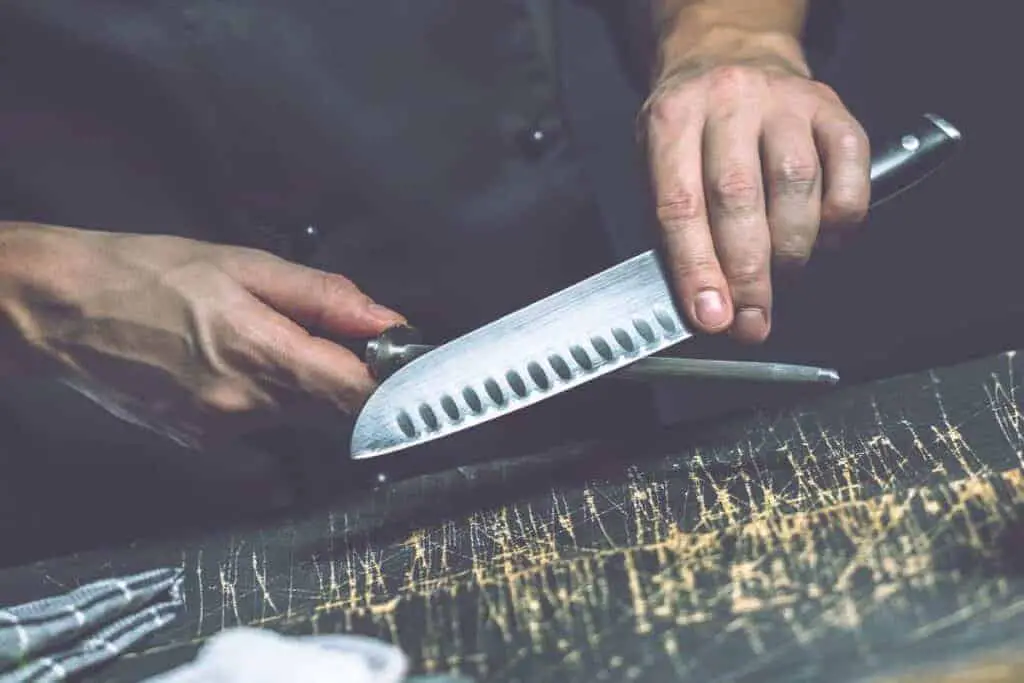This post contains affiliate links. As an Amazon Associate I earn from qualifying purchases
Table of Contents
How to Sharpen a Carving Knife
There are a lot of ways to sharpen a carving knife, perhaps too many. Here are the best solutions where we show you how to use a sharpening stone and a strop for that perfect finish.
Fortunately, you don’t need to own the most expensive knife in the world to be able to have a blade that can cut through almost anything.
Many of the more affordable carving knife brands have knives that can be sharpened to an ultra-fine edge. This gives you the quality of some of the most expensive professional carving knives, without needing to break the bank. Let’s take a look.
How to Sharpen a Carving Knife
Here are a few ways to sharpen a carving knife.
Method One – Push Away
For this method, you will want to lay the blade of your carving knife almost flat on a sharpening stone and push it away from you. The motion should feel as though you are trying to slice a thin layer of the stone clean off.
This method is perfect for knives that are only sharp on one side of the blade edge, which is known as single bevel knives. However, this method can also be used on double bevel knives – all you need to do is hold the knife in your other hand and perform the same motion.
Method Two – Drag Toward
This method involves once again laying the blade nearly flat on the stone but slightly angled. Then, drag the knife toward you, with the sharp side of the blade trailing.
You’ll want to be extra careful with this method. Try not to pull too hard, or you could cut yourself and cause some serious damage. You’ll also want to hold the stone steady enough so that it doesn’t move or slip.
Method Three – Circle Movements
For this third and final method, you are going to start the same as the previous two. Hold the knife almost flat against the stone, slightly at an angle.
Unlike the previous two steps, there is no pushing or pulling involved. Instead, you are going to make small circular movements with the blade across the stone.
This is particularly useful for double-beveled knives, as you can flip the blade every couple of circles to sharpen both sides simultaneously.
Stropping
The act of stropping involves polishing the edge of a sharp knife and is usually done right after a knife has been sharpened. It is done using a leather strap that is generally applied to a hard, stable surface.
Stropping helps clear away the last imperfections of the cut, and also further sharpens the blade. As an added bonus, stropping makes the blade more visually appealing, as after the process is done, the blade shines like a mirror. This is known as ‘mirror-edge’.
Stropping is a technique mostly used on classic razors, but is just as effective on pocket knives, kitchen knives, and, of course, carving knives. Leather strops can be bought, but making one is super easy, and can save you a lot of money.
Here’s how you can make a leather strop:
1. Get yourself a chunk of wood that is approximately ¾ inches thick, 1 ½ inches wide, and 16 inches long. Measurements don’t need to be exact, just similar.
2. Leave about 11 inches untouched, and carve a handle with a rounded shape out of the other leftover wood. You can carve handles into both ends, but one will usually suffice.
3. Drill a hole through the end of the handle, place some leather through it, and knot the ends.
4. Find a bit of leather with dimensions of 1 ½ x 11 inches. You can find scrap leather from shoe repair stores or craft shops, then glue the leather to the wood.
5. Coat the leather in a sharpening compound – a little goes a long way.
Now, strop the knife by laying it as flat as possible on the piece of leather, then draw the knife towards your body with the sharp end facing the opposite direction. Do this while holding the knife down with decent force.
After a few minutes, or even seconds, your knife will be incredibly sharp and ready to use, all without any effort at all.
That did all seem to be a lot of bother didn’t it? I think I will stick with a sharpening stone!
When Should You Sharpen Your Carving Knife
There are a number of ways you can test whether your knife is dull or not. Here’s three of them:
The Shaving Test
You could probably guess what this test involves just by its name. Run the knife along your arm or leg hair, and watch the hairs as they’re sliced while the blade glides through them.
If you notice any hair folding underneath the blade, you’ll know that it’s time to sharpen it. Also, keep in mind that you should not need to touch the blade to your skin for the hairs to come off.
The Paper Test
This is probably one of the most commonly used sharpness tests out there. Get yourself a piece of paper, hold it steady between your fingers, and slide the knife downward.
The knife will slice through the paper cleanly with its weight alone if it’s sharp. If the blade is dull, it will usually slip right off, or feel ragged. Magazine paper can provide even more accurate results, since it’s thin and slick, making it much more difficult to slice through.
The Tomato Test
Even though the tomato test is usually meant for kitchen knives, it works for all types of knives. You’ll need to rest your carving knife atop a tomato and pull towards yourself without applying any pressure.
You’ll know that the blade is dull if it does not slice through the tomato without the use of force. The skin on tomatoes is notoriously tricky to slice through, which is what makes this test so effective.
Wrapping Up
Whether you use it once a day or once a month, keeping your carving knife sharp is important if you want to be able to use it regularly, and if you want it to perform its best. Hopefully, we’ve made the task of sharpening your knife a little less challenging and made it easier for you to maintain that razor-sharp edge.


